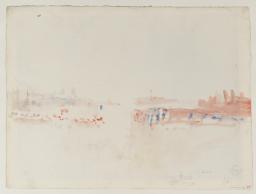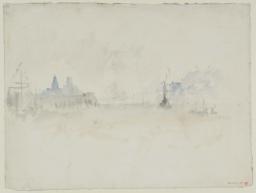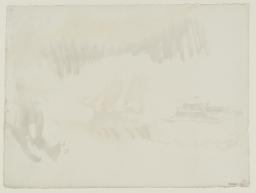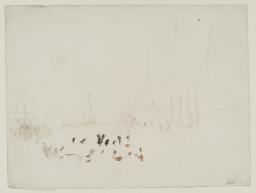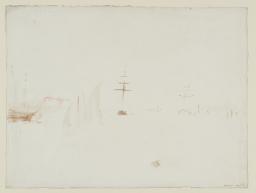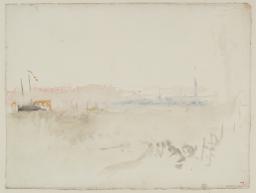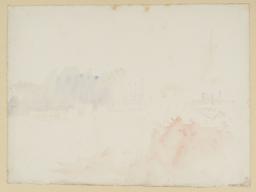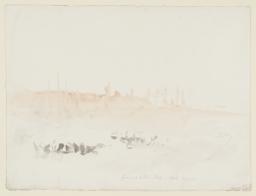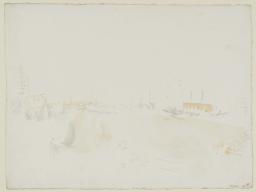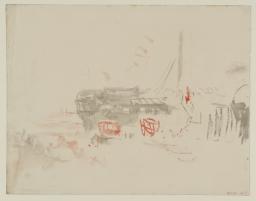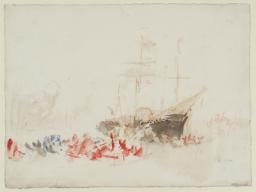Turner Bequest CCCXLIV 458, CCCLXIV 48, 57, 98, 99, 108, 109, 111, 114, 115, 116, 138
David Blayney Brown, Turner and the Channel: Themes and Variations c.1845, exhibition catalogue, Tate Gallery, London 1987, pp.20, 24
Robert Upstone, Turner: The Final Years: Watercolours 1840–1851, exhibition catalogue, Tate Gallery, London 1993, pp.52–4
Ian Warrell, ‘“I saw Louis Philippe land at Portsmouth”: Fixing Turner’s Presence at the Arrival of the King of the French, 8 October 1844’, Turner Society News, no.120, Autumn 2013, pp.9–10
Sam Smiles in David Blayney Brown, Amy Concannon and Smiles (eds.), Late Turner: Painting Set Free, exhibition catalogue, Tate Britain, London 2014, p.168
Robert Upstone, Turner: The Final Years: Watercolours 1840–1851, exhibition catalogue, Tate Gallery, London 1993, pp.52–4
Ian Warrell, ‘“I saw Louis Philippe land at Portsmouth”: Fixing Turner’s Presence at the Arrival of the King of the French, 8 October 1844’, Turner Society News, no.120, Autumn 2013, pp.9–10
Sam Smiles in David Blayney Brown, Amy Concannon and Smiles (eds.), Late Turner: Painting Set Free, exhibition catalogue, Tate Britain, London 2014, p.168
This grouping comprises one ink drawing (Tate D34961; Turner Bequest CCCXLIV 458) and eleven loose watercolour studies which can be related to the arrival of Louis-Philippe, King of the French, at Portsmouth Harbour on 8 October 1844, on board the Gomer, a large and distinctive hybrid sail-steamship. The circumstances of the visit are discussed in more detail in the overall Introduction to this section. Turner made many rapid pencil studies in a small sketchbook during the course of the day (Tate; Turner Bequest CCCLXII), but they have no very precise links to watercolours here and two unfinished paintings (see the overall Introduction).
The relationship of the watercolours gathered here to the events of October 1844 and the topography of Portsmouth and Gosport may seem somewhat tenuous at first sight. However, Tate D35981 (Turner Bequest CCCLXIV 138) is a direct representation of the Gomer, and D35942 and D35959 (CCCLXIV 99, 116) may show it too. D35888, D35899 and D35957 (CCCLXIV 48, 57, 114) appear to depict the cupola of Portsmouth Cathedral and nearby buildings on the skyline, while D35941 (CCCLXIV 98) may show the Gosport blockhouse. Flags and bunting are evident in D35899 and D34942, as well as D35951, D35952 and D35958 (CCCLXIV 108, 109, 115). Even D35954 (CCCLXIV 111), amongst the palest and least developed, shows a cluster of masts in the distance.
D35899, D35952, D35957–D35959, D35981 were exhibited together in 1987,1 when David Blayney Brown first approached an identification of their theme, albeit describing them as ‘probably, impossible to date on internal evidence. In view of their rather festive air they might perhaps be associated with events like Louis-Philippe’s arrival at Portsmouth in 1844, or the return visit of Victoria and Albert to Tréport in 1845’.2 D35981 and D35899 were exhibited in 1993, when Robert Upstone made the specific connection with the Portsmouth events,3 mentioning the six works shown previously in particular.4 In his comprehensive discussion of the subject, Ian Warrell subsequently connected a further five: D35888, D35941, D35942, D35951 and D35954.5
The studies are characterised by generally pale tones, activated here and there by touches of darker and stronger colour, giving an effect of bright light reflected from the waters of the extensive harbour. They are comparable in handling to other marine watercolours of the mid 1840s or later,6 such as one of an abandoned wreck inscribed ‘Lost to all hope’ (Yale Center for British Art, New Haven)7 and Wreck on the Goodwin Sands: Sunset (Morgan Library & Museum, New York),8 to colour studies in the sketchbooks used on two last visits to France in 1845, such as Ambleteuse and Wimereux (Tate; Turner Bequest CCCLVII) and the contemporary Ideas of Folkestone sketchbook (for example Tate D35362–D35363; Turner Bequest CCCLVI 2, 3).
Technical notes:
Robert Upstone has described most of the works here as ‘in watercolour alone, drawn with the brush’,9 and David Blayney Brown has described their handling as of ‘almost Oriental minimalism’, their execution being ‘both rudimentary and highly descriptive’:
The paper is left widely exposed, and only the briefest of pencil notes are suggested, but the hints of wash in pellucid pastels – blues, greys, browns and coral pinks – are dotted and dabbed to define masts, flags, a line of coast or a building. If we are reminded of calligraphy, we may well sense the handwriting of an old man – but one still imaginative and professional enough to muster his diminished resources to the best possible effect.10
Warrell has noted Upstone’s idea that the watercolours were made ‘in front of the subject’11 as a possibility, while having reservations about the practicalities of working in ‘cool autumnal weather conditions’ that would be ‘hardly conducive to plein-air work, except of the most rudimentary kind’.12 Warrell has observed that all except Tate D35959 (Turner Bequest CCCLXIV 116) were ‘cut down from a much larger piece’, and ‘since precisely the same colours can be found from image to image, it seems that Turner developed them as a batch, perhaps working across the large sheet, spread out in his studio’.13
Some of the sheets are numbered on their versos, possibly by Turner, although the significance of the sequence (and the gaps in it) remains unclear:
How to cite
Matthew Imms, ‘Studies Relating to the Arrival of Louis-Philippe, King of the French, at Portsmouth Harbour 1844’, subset, September 2016, in David Blayney Brown (ed.), J.M.W. Turner: Sketchbooks, Drawings and Watercolours, Tate Research Publication, March 2017, https://www


